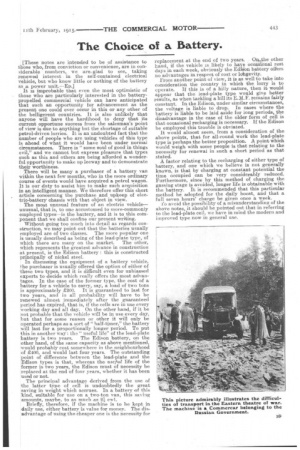The Choice of a Battery.
Page 17

If you've noticed an error in this article please click here to report it so we can fix it.
[These notes are intended to be of assistance to those who, from conviction or convenience, are in considerable numbers, we are glad to see, taking renewed interest in the self-contained electrical vehicle, but who know little or nothing of the battery as a power unit —ED.]
It is improbable that even the most optimistic of those who are particularly interested in the batterypropelled commercial vehicle can have, anticipated that such an opportunity for advancement as the present one could ever occur in this or any other of the belligerent countries. It is also unlikely that anyone will have the hardihood to deny that its current opportune success from the salesman's point of view is due to anything but the shortage of suitable petrol-driven lorries. It is an undoubted fact that the number of people who are using vehicles of this type is ahead of what it would have been under normal_ circumstances. There is "some soul of good in things evil," and we cannot but express pleasure that types such as this and others are being afforded a wonderful opportunity to make up leeway and to demonstrate their worthiness.
There will be many a purchaser of a battery van within the next few months, who in the more ordinary course of events would have acquired a petrol wagon. It is our duty to assist him to make such acquisition in an intelligent manner. We therefore offer this short article concerning the purchase and upkeep of electric-battery chassis with that object in view. The most unusual feature of an electric vehicle— unusual, that is, to one accustomed to more-commonly employed types—is the battery, and it is to this component that we shall confine our present writing. Without going too much into detail as regards construction, we may point out that the batteries usually employed are of two classes. The more popular one is usually described as being of the lead-plate type, of which there are many on the market. The other, which represents the greatest advance in construction at present, is the Edison battery : this is constructed principally of nickel steel.
In discussing the equipment of a battery vehicle, the purchaser is usually offered the option of either of these two types, and it is difficult even for unbiassed experts to decide which really offers the most advantages. In the case of the former type, the cost of a battery for a vehicle to carry, say, a load of two tons is approximately £200. It is guaranteed to last for two years, and in all probability will have to be renewed almost immediately after the guaranteed period has expired, that is, if the cells are in use every working day and all day. On the other hand, if it. be not probable that the vehicle will be in use every day, but that for some reason or other it will only be operated perhaps as a sort of " half-timer," the battery will last for a proportionally longer period. To put this in another way : the" useful life" of the lead-plate battery is two years. The Edison battery, on the other hand, of the same capacity as above mentioned, would probably cost somewhere in the neighbourhood of £400, and would last four years. The outstanding point of difference between the lead-plate and the Edison types is that, whereas the useful life of the former is two years, the Edison must of necessity be replaced at the end of four years, whether it has been used or not.
The principal advantage derived from the use of the latter type of cell is undoubtedly the great saving in weight which accrues. In a battery of this kind, suitable for use on a two-ton van, this saving amounts, maybe, to as much as 21 cwt. Briefly, therefore, if the machine is to be kept in daily use, either battery is value for money. The disadvantage of using the cheaper one is the necessity for
replacement at the end of two years. 04.(the other hand, if the vehicle is likely to haye occasional rest i
days n each week, obviously the Edision battery ofFers no advantages in respect of cost or longevity. From another point of view, it is as well to take into consideration the country in which the lorry is to operate. If this is of a hilly nature, then it would appear that the lead-plate type would give better results, as when tackling a hill its E.M.F. remains fairly constant. In the Edison, under similar circumstances, the voltage is liable to drop. In cases where the battery is liable to be laid aside for long periods, the disadvantage in the case of the older form of cell is that occasional recharging is necessary. If the Edison be employed this trouble is obviated. It would almost seem, from a consideration of the above points, that for all-round work the lead-plate type is perhaps the better proposition. A point which would weigh with some people is that relating to the necessity for renewal in such a short period as that stated.
A factor relating to the recharging of either type of battery, and one which we believe is not generally known, is that by charging at constant potential the time occupied can be very considerably reduced. Furthermore, since by this method of charging the gassing stage is avoided, longer life is obtainable with the battery. It is recommended that this particular method be adopted for the daily boost, and that a full seven hours' charge be given once a week. To avoid the possibility of a misunderstanding of the above notes, it should be pointed out that in referring to the lead-plate cell, we have in mind the modern and improved type now in general use.






















